Cotechino (Homemade Italian Sausage Recipe)
This homemade cotechino recipe is an authentic Italian sausage recipe which contains many parts of the pig, and makes so many dishes incredibly flavorful! The recipe is from my Nonna Chiarina who lived in Lazio.
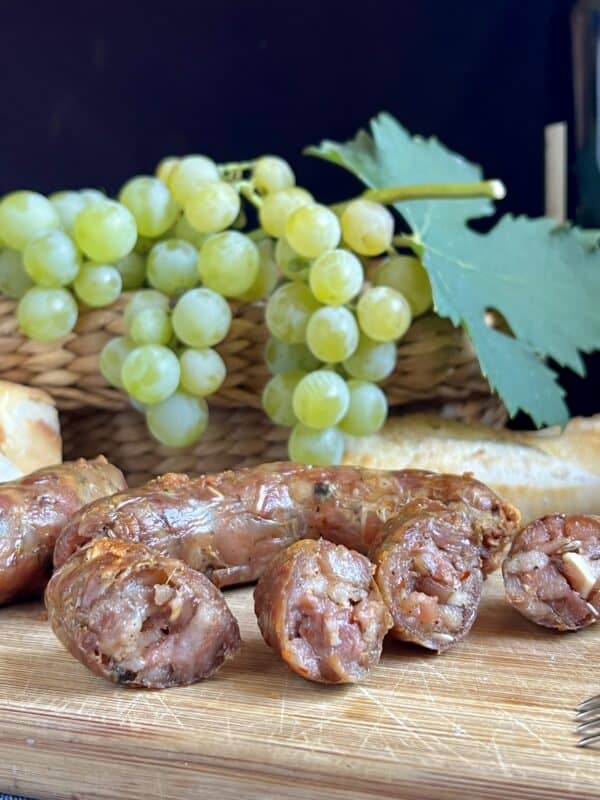
This cotechino sausage is very near the top of my list of favorite foods.
WARNING: vegetarians, this post is not for you.
As an Amazon Associate I earn from qualifying purchases.
I wasn’t going to publish this recipe when we made it, simply because I thought my (mostly) American audience wouldn’t approve. However, I have decided to share it for several reasons, but the top two being that I always post recipes that I love, and the fact that if you eat pork, there should be no issue in a recipe that uses more of the animal than less.
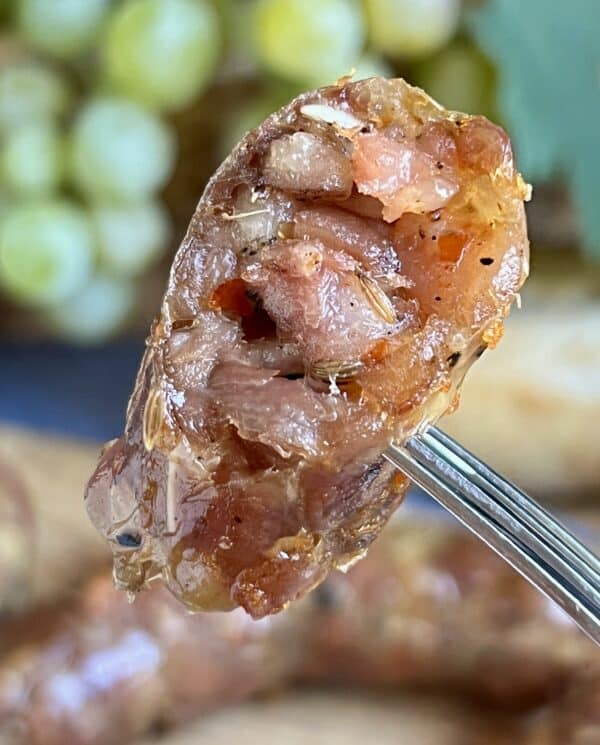
Let’s face it, the US isn’t the best at using the entire animal whether it’s a cow, pig or other animal. I once asked in Whole Foods if I could order pork belly with the rind on (because it’s always sold without) and was told that they stopped selling it that way because “people complained”. This sort of thinking does my head in. I wish there were more people with a mindset like Ashley from Practical Self Reliance who writes articles like Cooking with Animal Fat.
We have killed an animal to eat it, so why not make use of every single part of that animal? Does it make those people feel better to throw away parts of the animal just because it makes them feel uncomfortable? I can totally empathize with vegetarians when they have to hear things such as this.
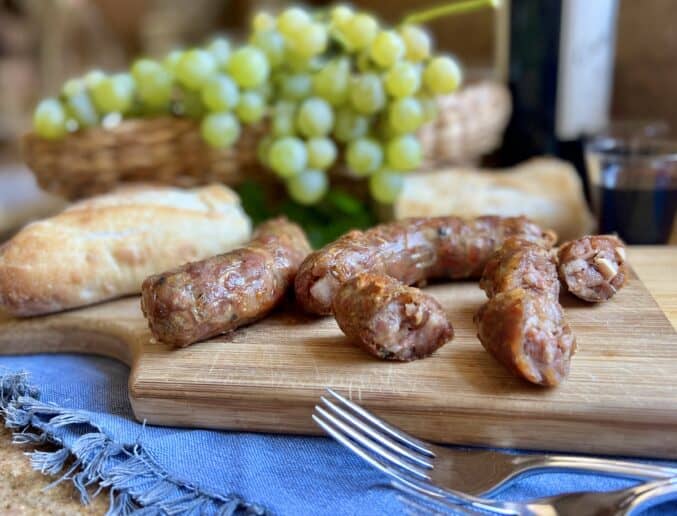
What is Cotechino (and What Does it Mean in English)?
Cotechino is an Italian sausage that is made from different types of pork meat, and other non-meat parts. It uses more of the pig than normal pork sausages. It’s a recipe that is considered “nose to tail” cuisine.
The English translation of cotechino is “little pork rind”. Cotiche is the word for pork rind, and “ino” is a suffix which makes the base “small”. So translations telling you cotechino means “pork sausage” are inaccurate. It’s what cotechino is, not what the translation is.
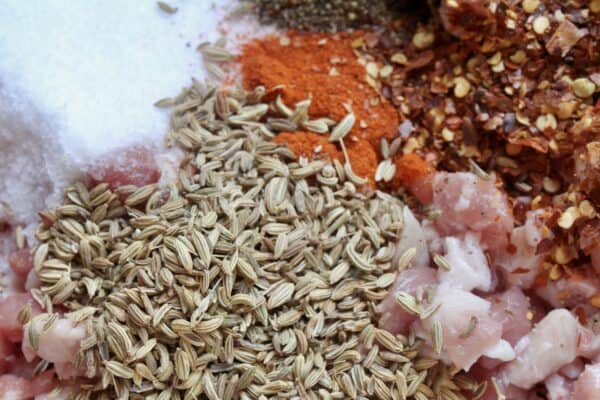
What is Cotechino Sausage Made of?
Cotechino is made from pork meat, rind, pork fat, pork cheek/snout, pig’s ears, salt and spices, or a variation of these ingredients. It makes use of more of the pig than traditional pork sausages.
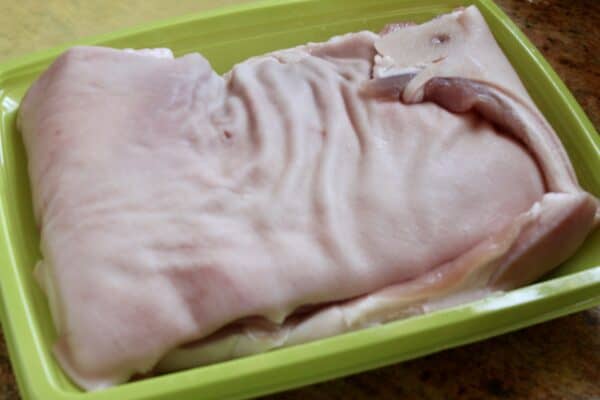
This cotechino recipe is a bit more rustic than the Northern Italian version which I tasted in Emilia-Romagna. If you prefer, you can grind everything in a meat grinder (heavy duty). This is a cucina povera recipe, and although I may be biased, I definitely prefer my Nonna’s recipe which doesn’t contain as many spices, like cinnamon and cloves, as other versions.
Did you know cotechino and lentils is served on New Year’s Eve to bring in the year with good luck?
It’s a chewy, crunchy, and phenomenally delicious sausage! It may not be the prettiest sausage, but what it lacks in looks, it makes up for in flavor!
Love pork? You have to try this porchetta recipe which I brought back from Italy.
NOTES: it is important to buy the best quality, fresh pork meat you can find, preferably organic. These sausages are normally dry cured in Italy, however, we vacuum-sealed most of them and froze them instead. If you are able to source good quality pork products, you could dry the cotechino in your fridge in the same manner as I make pancetta.

Homemade Cotechino Recipe
Recipe by Lidia Conte (from my Nonna Chiarina). Makes about 18 sausages
FULL PRINTABLE RECIPE BELOW
Special equipment/ingredients: handheld sausage funnel, natural hog casings and butcher’s twine
Ingredients
- pork belly with skin
- pork shoulder
- pig ears
- pig snout/cheek meat
- Kosher (Diamond) salt
- fennel seed
- crushed red pepper flakes
- Tbsp freshly ground black pepper
- whole black peppercorns
- cayenne powder
How to Make Nose to Tail Sausages
Rinse the hog casings by running water inside of them. Next, allow to soak in a mixture of water, and a splash of white vinegar while you prepare the meat.
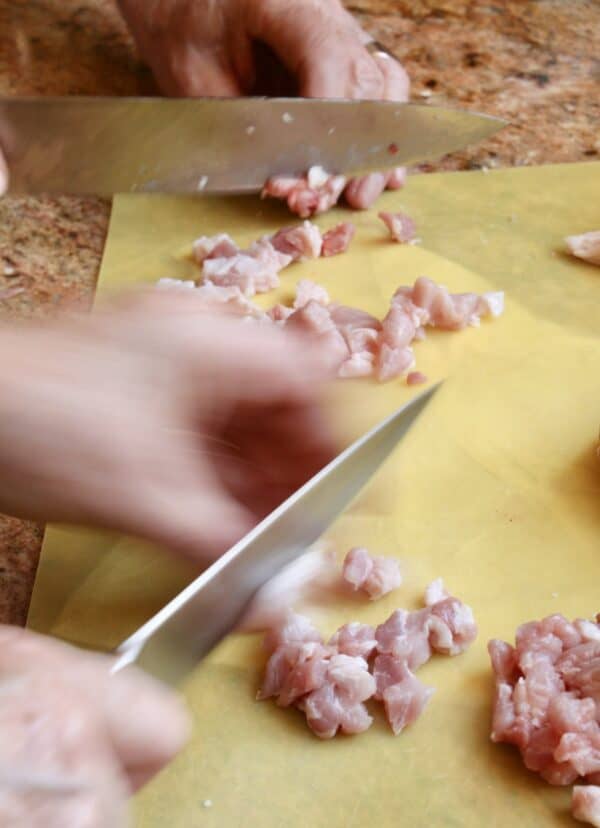
Start by cutting up all the pork meat, cheek, snout and ears into ¼” to ½” (about .75 cm) pieces (smaller is better).
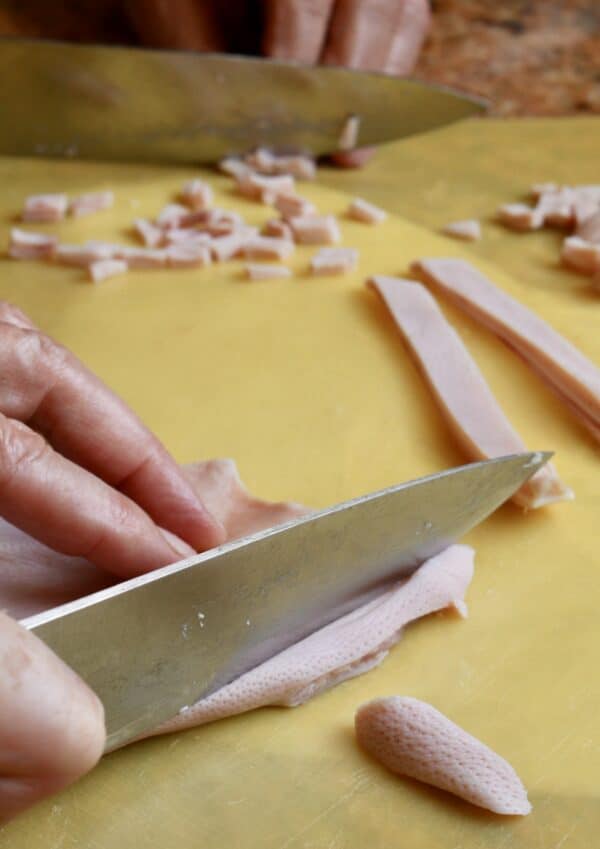
You will definitely want to use a sharp knife for cutting all these pieces, especially since some parts are quite tough. Place in a bowl and store in the fridge.
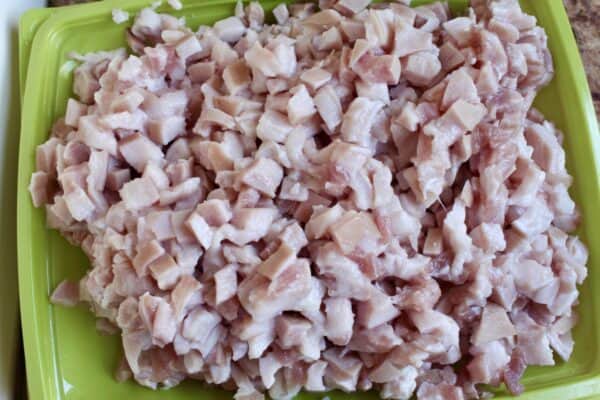
Cut the pork rind into the same sized pieces.
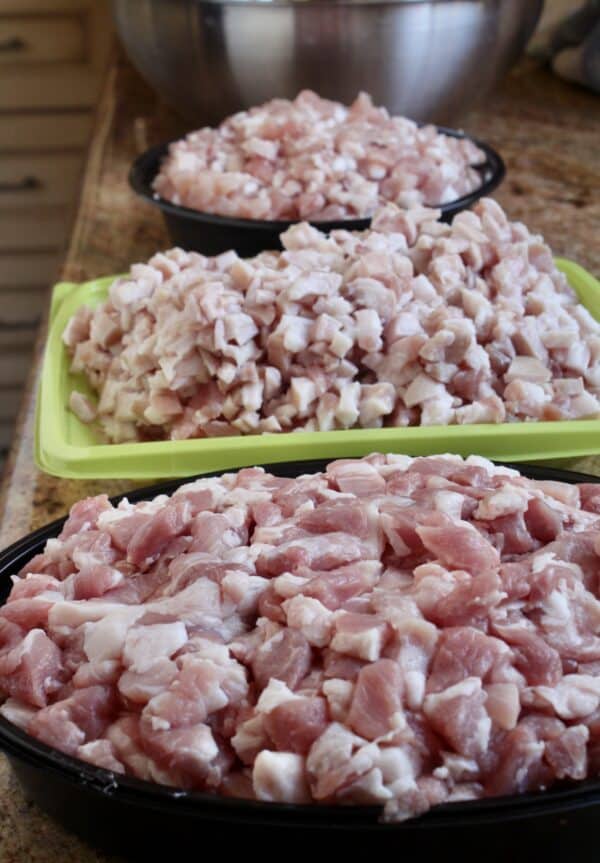
Bring the other cut pieces of pork out of the fridge.
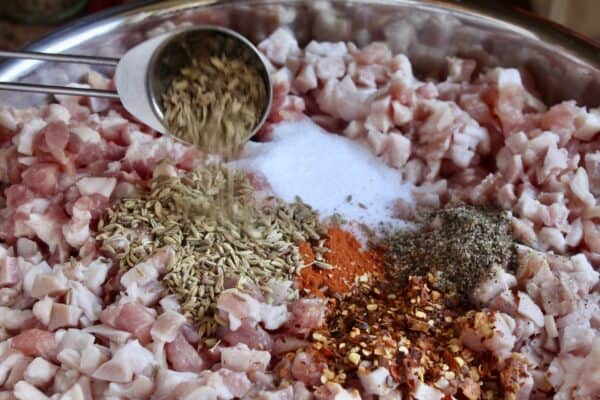
Place all the cut pork products into a very large bowl, then add the salt, pepper and spices.
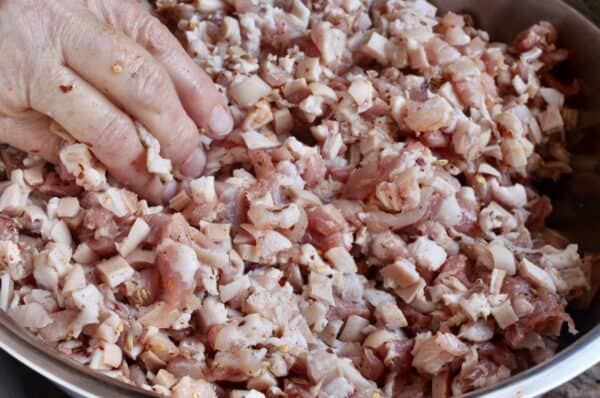
Mix all the ingredients together by hand until everything is evenly distributed (about 10 minutes of mixing). This is a very important step. (Although we love this ratio of ingredients for the cotechino, but you can cook a little of the mixture and taste it yourself to adjust the seasonings before stuffing the sausages.)
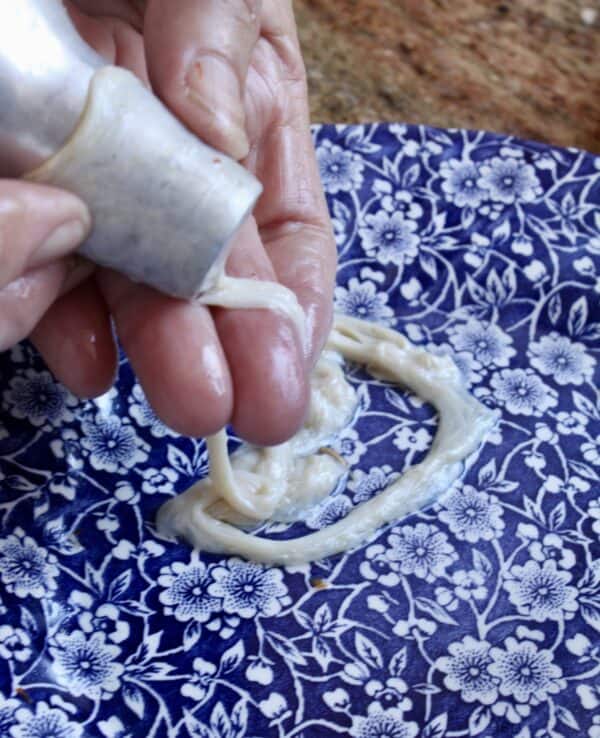
Tie off an end of a casing, then feed the entire length onto the end of the funnel. The length does not matter.
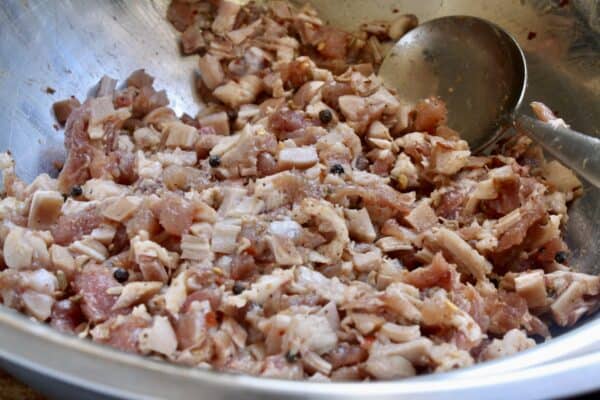
Spoon the mixture into the funnel and squeeze into the casing, making sure to not have too much air pockets. (This is the part where you definitely want help.)
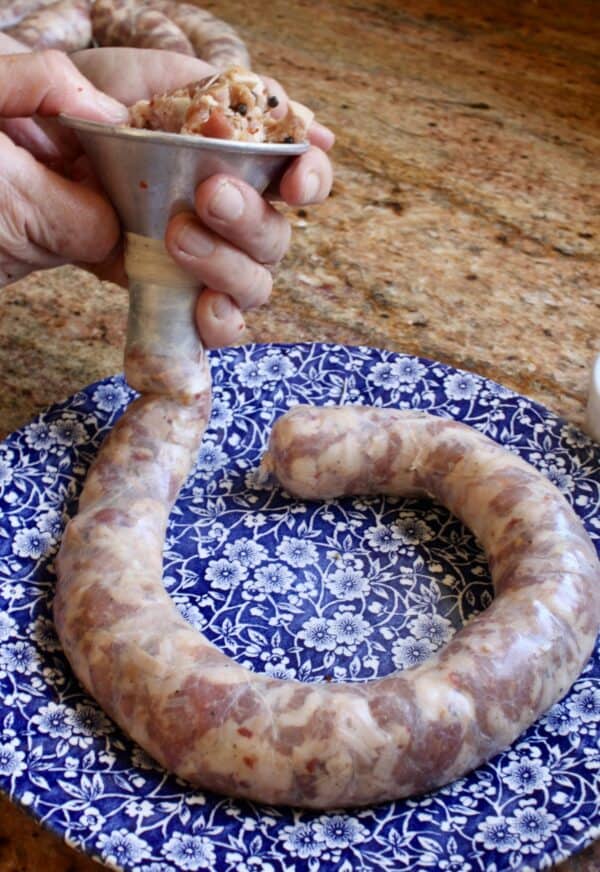
If you see larger air pockets, poke the casing with a sharp tool (like a toothpick), and work the air gap out. Do this as you stuff the cotechino sausages.
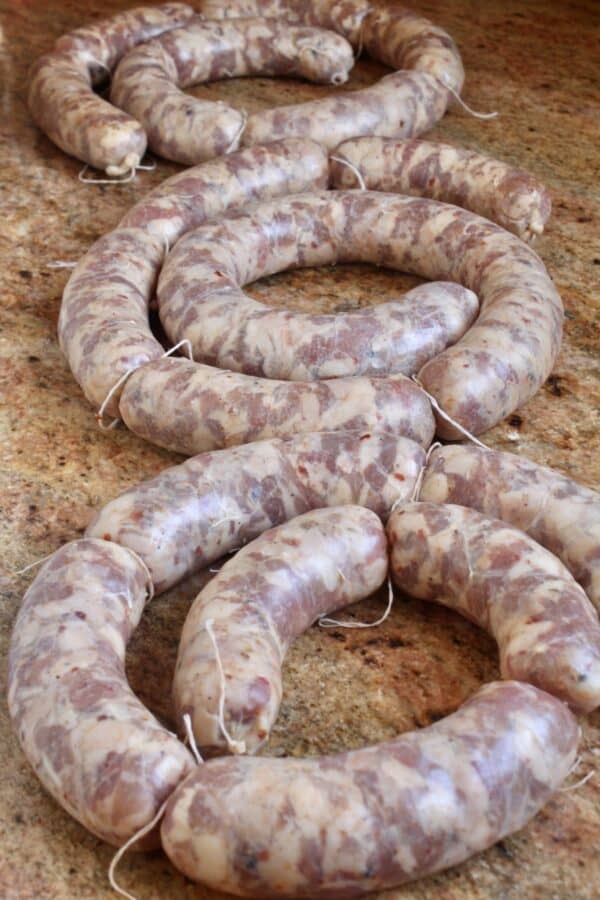
Tie off the sausages with the butcher’s string into approximately 5″ (13 cm) lengths (or whatever you like).
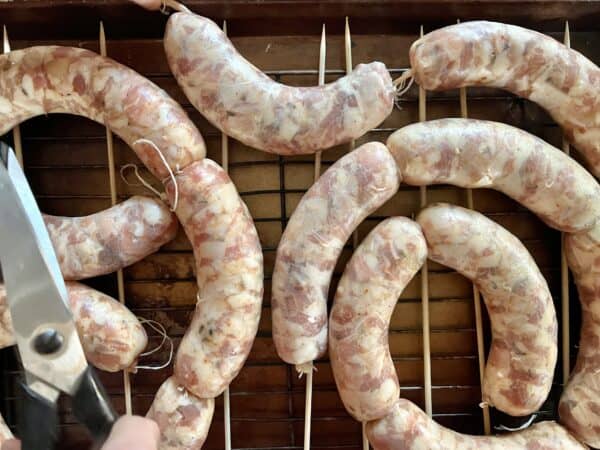
Prick the sausages all over, to get rid of any more air gaps.
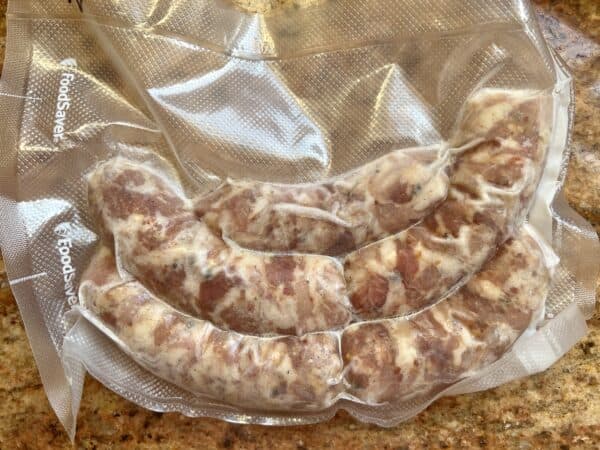
If you aren’t dry-curing them, freeze them until solid, and then place into vacuum-sealer bags and seal. Place back into the freezer. These will keep in the freezer for 6 months (if you don’t use vacuum bags), then only keep frozen for up to a month.
How to Use Cotechino

- Cotechino is incredibly good when added to minestra, a dish made with lots of different greens and beans.
- Cotechino and lentils is a typical New Year’s dish (for good luck, and wealth) in Italy!
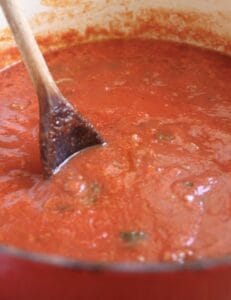
- Adding cotechino to your garlic and olive oil when making pasta sauce (replace the ground beef in this recipe) makes a delicious sauce, especially when using it for pasta and beans!
- Of course, it’s so delicious, I sometimes just cook it in the air-fryer and eat it plain with some bread!

More Pork Recipes
Cumberland Sausages (a very British sausage recipe)
Pork and Pickled Peppers (another one of Nonna Chiarina’s recipes)
Pancetta Pasta (only 4 ingredients, and super delicious)
Please let me know if you make cotechino as it would truly make my day!

Homemade Cotechino Recipe
Special Equipment
- 1 handheld sausage funnel
- butcher's twine
Ingredients
Cotechino Sausage:
- 3 lbs pork belly (with skin)
- 1 lbs pork shoulder
- 1 lb pig ears (about 3)
- 1 ½ lb pig snout/cheek meat
- 3 Tbsp salt (Kosher Diamond)
- 3 Tbsp fennel seed
- 1 Tbsp crushed red pepper flakes
- 1 Tbsp black pepper (freshly ground)
- 2 Tbsp black peppercorns
- 1 tsp cayenne powder (to 1 Tbsp depending on your preference, optional)
Casings:
- natural hog casings (as needed)
- water (as needed for soaking casings)
- 1 Tbsp white vinegar (a splash, poured in the water)
Instructions
How to Make Cotechino Sausages:
- Rinse the hog casings by running water inside of them. Next, allow to soak in a mixture of water, and a splash of white vinegar while you prepare the meat.
- Start by cutting up all the pork meat, cheek, snout and ears into ¼" to ½" (about .75 cm) pieces (smaller is better). Store in the fridge.
- Cut the pork rind into the same sized pieces.
- Bring the other cut pieces of pork out of the fridge.
- Place all the cut pork products into a very large bowl, then add the salt, pepper and spices.
- Mix all the ingredients together by hand until everything is evenly distributed (about 10 minutes of mixing). This is a very important step. (Although we love this ratio of ingredients, you can cook a little of the mixture and taste it yourself to adjust the seasonings before stuffing the sausages.)
- Tie off an end of a casing, then feed the entire length onto the end of the funnel. The length does not matter
- Spoon the mixture into the funnel and squeeze into the casing, making sure to not have too much air pockets. (This is the part where you definitely want help.
- If you see larger air pockets, poke the casing with a sharp tool (like a toothpick), and work the air gap out. Do this as you stuff the sausages
- Tie off the sausages with the butcher's string into approximately 5" (13 cm) lengths (or whatever you like), then prick the sausages all over, to get rid of any more air gaps.
- If you aren't dry-curing them, freeze them until solid, and then place into vacuum-sealer bags and seal. Place back into the freezer. These will keep in the freezer for 6 months (if you don't use vacuum bags, then only keep frozen for up to a month.
Notes
- Tip: try to have help (at minimum) for the stuffing and tying part.
- How to Use Cotechino
-
- Adding cotechino to your garlic and olive oil when making pasta sauce (replace the ground beef in this recipe) makes a delicious sauce, especially when using it for pasta and beans!
- Of course, it's so delicious, I sometimes just cook it in the air-fryer and eat it plain with some bread!
Nutrition
Christina’s Cucina is a participant in the Amazon Services LLC Associate Program, an affiliate advertising program designed to provide a means for sites to earn advertising fees by advertising and linking to Amazon.com.


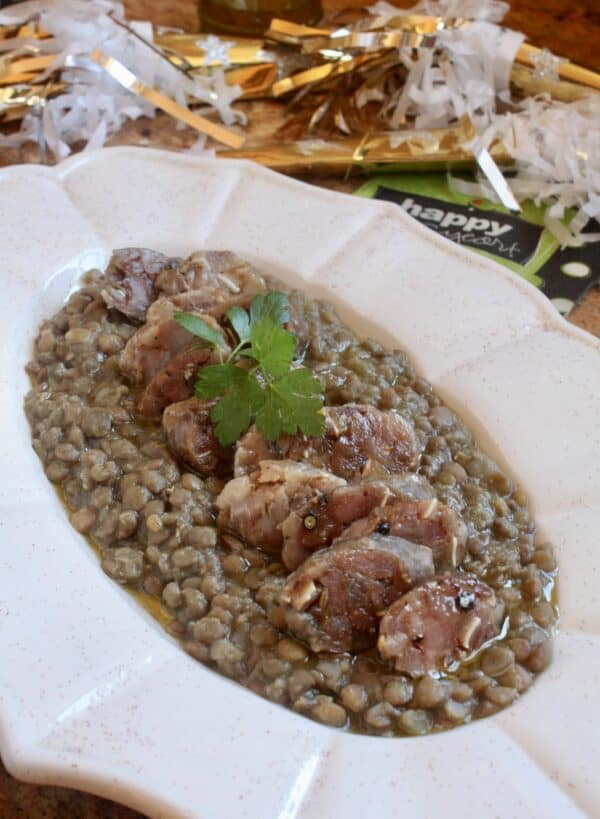
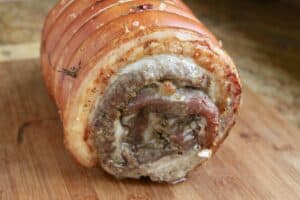
Italian friends of mine tried Haggis while in Scotland and said it’s very similar to Cotechino. Every country knew how to use the whole animal in days gone by! We’ve become so fussy!
In some ways it is because it uses so much of the animal, but in flavor I would say it’s very different. I agree, sadly, much too fussy! If you eat meat, you should WANT to use as much of the animal as possible. It’s only right! Thanks, Moira!